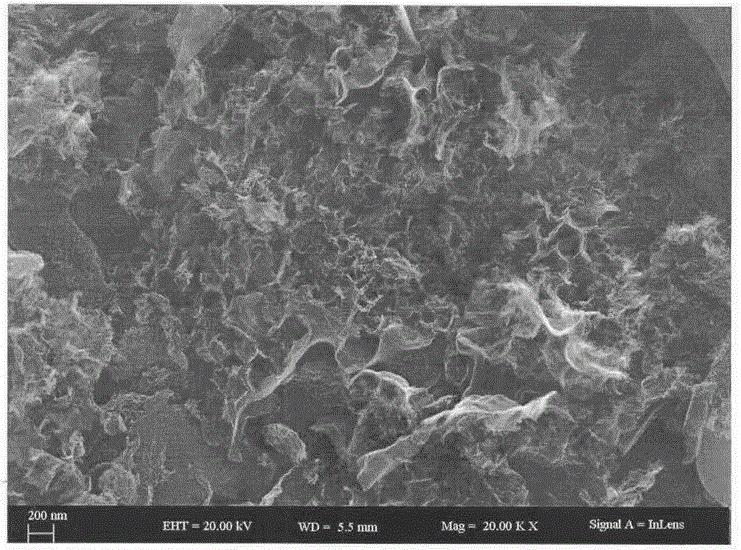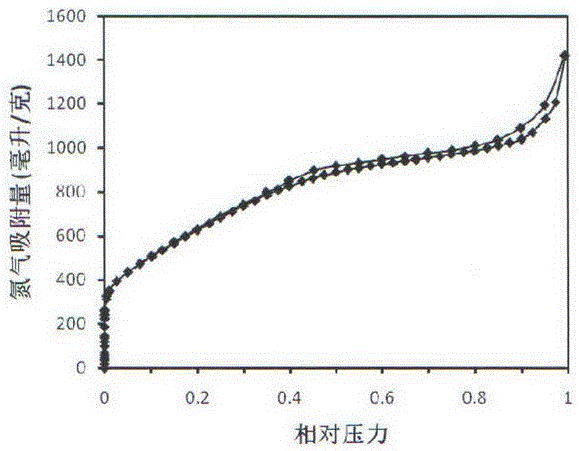Application and preparation method of biomass-based nitrogen-doped porous carbon
A nitrogen-doped porous carbon and biomass technology, applied in the direction of carbon preparation/purification, chemical instruments and methods, alkali metal compounds, etc., can solve problems that are not suitable for large-scale production and industrial applications, complex preparation processes, and expensive precursors and other problems, to achieve high adsorption capacity, simple process, and reduce costs
- Summary
- Abstract
- Description
- Claims
- Application Information
AI Technical Summary
Problems solved by technology
Method used
Image
Examples
Embodiment 1
[0066] a. Dissolve 5g of sodium hydroxide in 50ml of water and stir to dissolve, add 15g of urea and stir to dissolve, at a temperature of 10°C, add 5g of cellulose carbamate, and mechanically stir vigorously for 12min to obtain a uniform cellulose carbamate / Urea / sodium hydroxide sol solution, and then put the sol solution in an evaporating dish, spread it flat, and dry it at a temperature of 80°C for 5 hours to obtain a sol;
[0067]b. Under the protection of nitrogen, put the dried sol in step a into a tube furnace for calcination, raise the temperature to 550°C at a rate of 5°C / min, keep it for 1h, then raise the temperature to 700°C, and keep it for 1h. A black solid was obtained, and then the black solid was washed with water and 10 wt % hydrochloric acid until neutral, and dried at 120° C. for 4 hours to obtain biomass-based nitrogen-doped porous carbon.
Embodiment 2
[0069] a. Dissolve 5g of sodium hydroxide in 50ml of water and stir to dissolve, add 15g of urea and stir to dissolve, at a temperature of 8°C, add 5g of cellulose carbamate, and mechanically stir vigorously for 10min to obtain a uniform cellulose carbamate / Urea / sodium hydroxide sol solution, and then put the sol solution in an evaporating dish, spread it flat, and dry it at a temperature of 60°C for 6 hours to obtain a sol;
[0070] b. Under the protection of nitrogen, place the dried sol in step a for calcination in a tube furnace, raise the temperature to 550°C at a rate of 5°C / min, keep it for 1h, then raise the temperature to 800°C, and keep it for 1h. A black solid was obtained, and then the black solid was washed with water and 10 wt % hydrochloric acid until neutral, and dried at 120° C. for 4 hours to obtain biomass-based nitrogen-doped porous carbon.
Embodiment 3
[0072] a. Dissolve 5g of sodium hydroxide in 50ml of water and stir to dissolve, add 15g of urea and stir to dissolve, at a temperature of 15°C, add 5g of cellulose carbamate, and mechanically stir vigorously for 15min to obtain a uniform cellulose carbamate / Urea / sodium hydroxide sol solution, and then put the sol solution in a 50ml beaker, spread it flat, and dry it at a temperature of 70°C for 9 hours to obtain a sol;
[0073] b. Under the protection of nitrogen, place the dried sol in step a for calcination in a tube furnace, raise the temperature to 550°C at a rate of 5°C / min, keep it for 1h, then raise the temperature to 900°C, and keep it for 1h. A black solid was obtained, and then the black solid was washed with water and 10 wt % hydrochloric acid until neutral, and dried at 120° C. for 4 hours to obtain biomass-based nitrogen-doped porous carbon.
PUM
 Login to View More
Login to View More Abstract
Description
Claims
Application Information
 Login to View More
Login to View More - R&D
- Intellectual Property
- Life Sciences
- Materials
- Tech Scout
- Unparalleled Data Quality
- Higher Quality Content
- 60% Fewer Hallucinations
Browse by: Latest US Patents, China's latest patents, Technical Efficacy Thesaurus, Application Domain, Technology Topic, Popular Technical Reports.
© 2025 PatSnap. All rights reserved.Legal|Privacy policy|Modern Slavery Act Transparency Statement|Sitemap|About US| Contact US: help@patsnap.com



